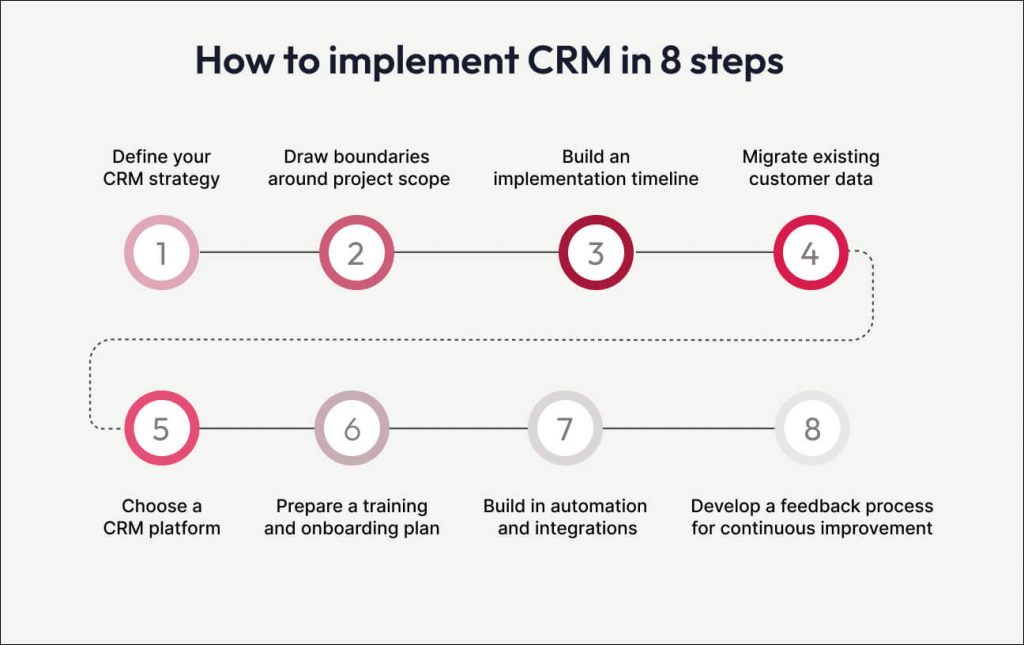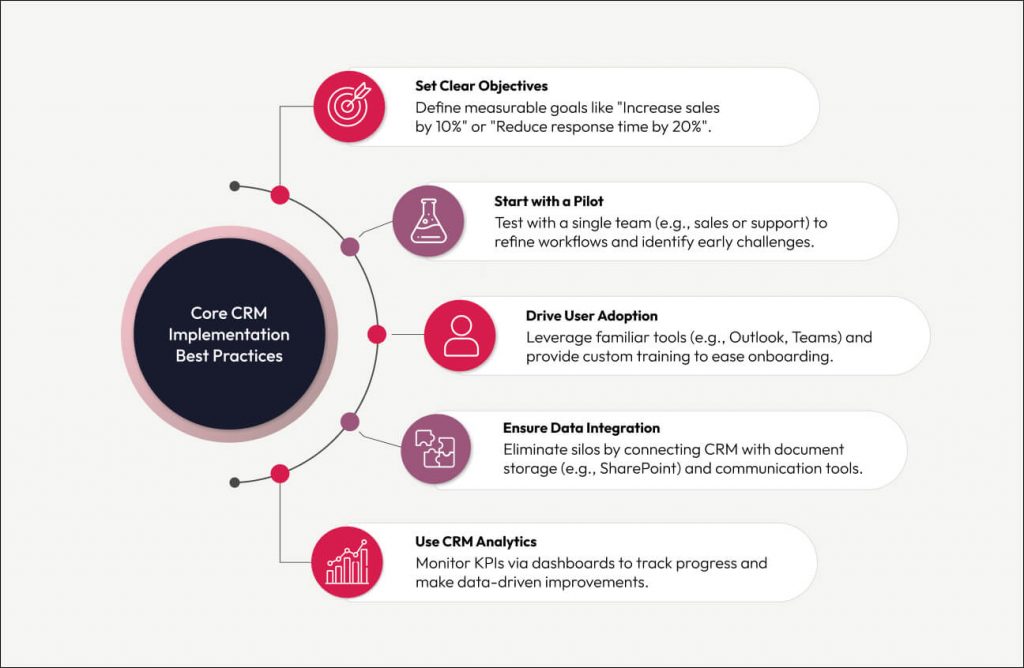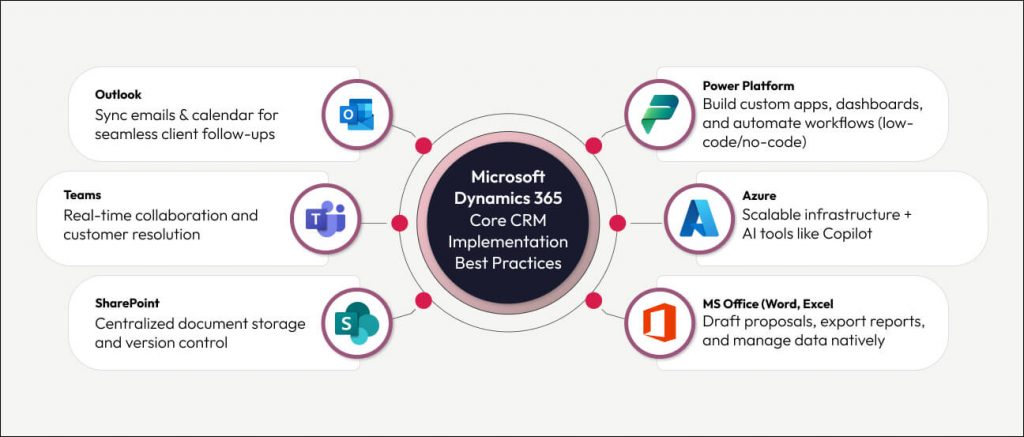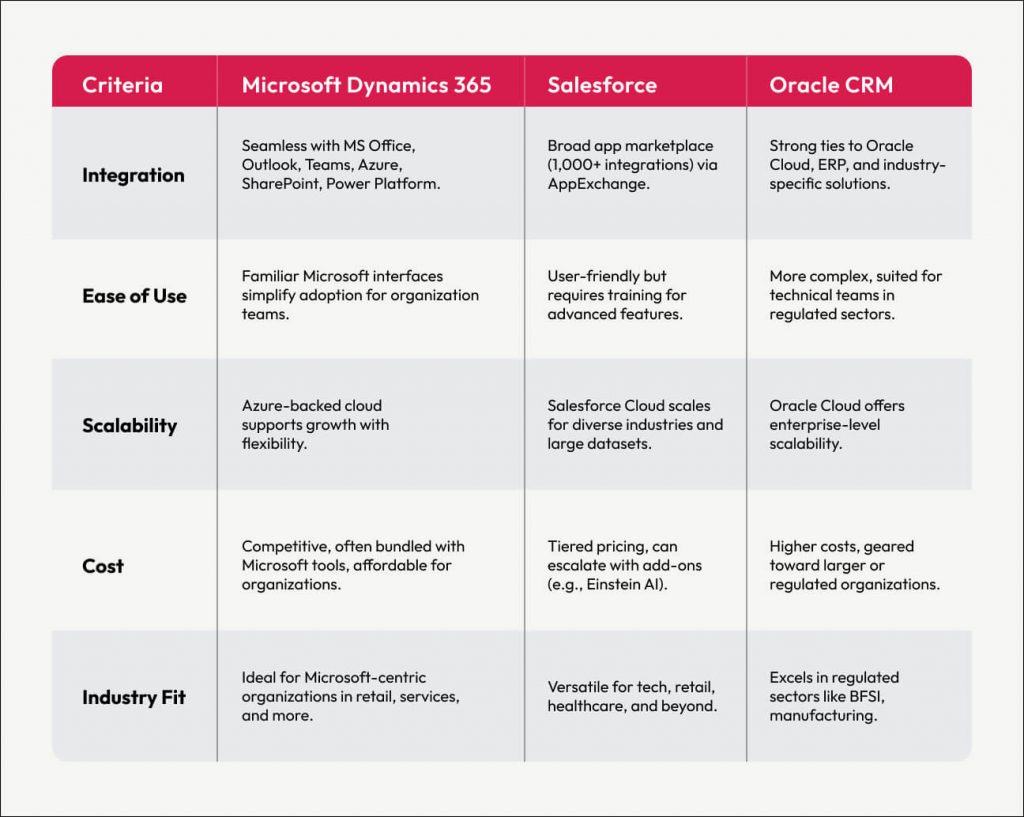In today’s competitive market, CRM implementation is essential for mid-sized businesses aiming to thrive. Beyond basic contact management, CRM software cultivates customer loyalty, streamlines operations, and drives growth. Effective CRM implementation can boost customer retention by up to 15% and decrease operational expenses by up to 20% (Salesmate, 2025). Successful CRM adoption is critical; poor implementation can lead to wasted resources and frustrated teams. This guide explores the importance of CRM for business growth and provides strategies for effective implementation, featuring Microsoft Dynamics 365, Salesforce CRM, and Oracle CRM as leading platform options.
Building a connected CRM experience
Microsoft Dynamics 365 delivers a unified CRM ecosystem by seamlessly integrating with the Microsoft suite: MS Office, Outlook, Teams, Azure, SharePoint, and Power Platform. This integration creates a CRM that feels like a natural extension of existing organizational tools. Imagine sales teams drafting proposals in Word, managing client emails in Outlook, collaborating via Teams, storing contracts in SharePoint, and scaling operations with Azure cloud. The Power Platform’s low-code capabilities enable non-technical users to quickly build custom apps, like a customer feedback portal. This cohesive ecosystem transforms CRM software from a standalone system into an intuitive part of daily workflows, boosting efficiency and user adoption.

Collaboration in CRM integration
The power of a unified CRM stems from the collaboration of its integrated tools. Outlook seamlessly syncs email interactions with CRM records, ensuring no follow-up opportunity is missed—essential as 80% of sales require multiple touchpoints (Forrester). Teams enables real-time collaboration, allowing sales and support teams to resolve customer issues in shared channels, potentially reducing response times by 25% (Microsoft case study). Azure provides scalability and powers AI features like Copilot, which can predict customer churn with 85% accuracy. SharePoint centralizes document storage, making proposals and contracts easily accessible within the CRM system. Power Platform’s flexibility allows teams to build tailored solutions without significant IT investment. For example, a retailer used Power Platform to create a custom inventory tracker, reducing stock discrepancies by 30% (Microsoft, 2024). These integrated CRM tools make Dynamics 365 a versatile choice, paving the way for effective CRM implementation through best practices.
Core strategies for CRM implementation
Effective CRM implementation requires a strategic approach. Follow these CRM implementation best practices to ensure successful adoption and measurable results. First, define clear objectives—such as growing sales by 10% or reducing service response times by 20%—and use CRM analytics to track progress. For example, a logistics firm used Dynamics 365 dashboards to monitor delivery satisfaction, improving it by 15% in six months. Prioritize user adoption by leveraging familiar interfaces (e.g., Outlook integration, Teams integration within Dynamics 365) and investing in tailored CRM training. Microsoft reports that organizations with structured training see 40% higher adoption rates. Ensure data quality by integrating with ecosystem tools to eliminate data silos—Dynamics 365’s SharePoint integration, for example, unified customer data for a financial services firm, reducing errors by 25%. Follow these CRM best practices for successful implementation.

Scaling CRM implementation with precision
To achieve CRM implementation with precision, begin with a pilot project, such as deploying CRM software for a single sales team, to test workflows and gather feedback. A UK retailer piloted Dynamics 365 for their customer service team, resolving 90% of issues faster before full-scale implementation (Microsoft, 2023). Scale strategically using Azure cloud flexibility to handle growth without disruption. Finally, leverage AI in CRM and CRM analytics, such as Dynamics 365 Copilot, to deliver personalized customer experiences. A mid-tier e-commerce company used Copilot to tailor promotions, boosting conversion rates by 12%. These practices, enhanced by the Dynamics 365 ecosystem, ensure CRM aligns with business goals and delivers lasting value.
Cross-platform CRM implementation strategies
The best practices for CRM implementation discussed are universal and applicable to all leading CRM platforms, not just Dynamics 365. Salesforce, with its Einstein AI, excels in predictive analytics and CRM customization, ideal for organizations targeting rapid expansion. For example, a tech startup used Salesforce to automate lead scoring, increasing conversions by 18% (Salesforce, 2024). Oracle CRM, with its enterprise-grade integration, suits regulated sectors like banking, where CRM compliance is critical. A European bank leveraged Oracle’s CRM to streamline compliance reporting, saving 15 hours weekly (Oracle case study). Both platforms support defining CRM objectives, driving CRM adoption, ensuring CRM data quality, piloting CRM projects, and using CRM analytics, just as Dynamics 365 does. Salesforce emphasizes flexibility, Oracle prioritizes robustness, and Dynamics 365 leverages Microsoft’s familiarity. These core CRM strategies remain firm, allowing IT experts to apply them to any CRM system with confidence.

CRM platform analysis: Dynamics 365 vs. Salesforce vs. Oracle
Selecting the right CRM is a pivotal decision. The table below compares Microsoft Dynamics 365, Salesforce, and Oracle CRM across key factors to guide IT experts.

Each CRM platform offers unique strengths. Dynamics 365 provides cost-effectiveness and familiarity for organizations using Microsoft tools. Salesforce delivers unmatched CRM customization, leading to reportedly 30% faster deal closures in some cases. Oracle excels in regulated environments, supporting complex CRM compliance needs. For example, a retailer might choose Dynamics 365 for its Microsoft integration, while a tech organization might pick Salesforce for its flexibility. The decision on the best CRM hinges on your organization’s priorities: ease of use, CRM cost, or industry alignment.
Transforming business with CRM
CRM is a transformative force for mid-tier organizations, driving customer loyalty, operational efficiency, and business growth. By embracing CRM best practices—clear objectives, user adoption, data integration, phased rollouts, and CRM analytics—IT experts can maximize its impact. Platforms like Microsoft Dynamics 365, Salesforce, and Oracle offer distinct strengths, from Dynamics 365’s familiar ecosystem to Salesforce’s versatility and Oracle’s robustness. Evaluate your needs, align CRM strategy with your goals, and implement them with precision. CRM isn’t just about managing customers—it’s about mastering business growth. With the right approach and the right technology partner, you’re poised to lead your organization to new heights of success.





